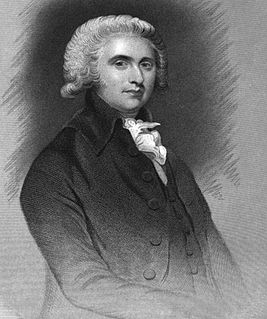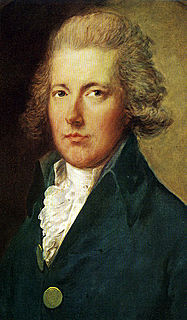Related Research Articles
"Easter Holidays" is a poem by Samuel Taylor Coleridge, which he wrote at age fifteen in 1787. It is one of his earliest known poems and was included in a letter to his brother Luke. The poem describes the joy of Easter but also warns of possible future sorrows after one loses his innocence. The poem concludes with a Neoplatonic emphasis of virtue being able to conquer suffering.
The Destruction of the Bastile was composed by Samuel Taylor Coleridge in 1789. The poem describes Coleridge's feelings of hopes for the French Revolution as a catalyst for political change.
"Pain: Composed in Sickness" is a poem by Samuel Taylor Coleridge. The poem marks a time in Coleridge's life in which he began to take opium.
On Receiving an Account that his only Sister's Death was Inevitable was composed by Samuel Taylor Coleridge in 1794. It was written for Coleridge's friend Charles Lamb and seeks to comfort him after his loss.
Lines Written at Shurton Bars was composed by Samuel Taylor Coleridge in 1795. The poem incorporates a reflection on Coleridge's engagement and his understanding of marriage. It also compares nature to an ideal understanding of reality and discusses isolation from others.
Religious Musings was composed by Samuel Taylor Coleridge in 1794 and finished by 1796. It is one of his first poems of critical merit and contains many of his early feelings about religion and politics.
Ode on the Departing Year was composed by Samuel Taylor Coleridge in 1796. The poem describes Coleridge's feelings on politics and religion, and it emphasises an idyllic lifestyle as an optimal way of living.
"On Quitting School" is a sonnet written by Samuel Taylor Coleridge in 1791. It describes Coleridge's feelings of leaving school for Cambridge in an optimistic manner quite contrary to the views he expressed later in life.

The conversation poems are a group of at least eight poems composed by Samuel Taylor Coleridge (1772–1834) between 1795 and 1807. Each details a particular life experience which led to the poet's examination of nature and the role of poetry. They describe virtuous conduct and man's obligation to God, nature and society, and ask as if there is a place for simple appreciation of nature without having to actively dedicate one's life to altruism.
The Eolian Harp is a poem written by Samuel Taylor Coleridge in 1795 and published in his 1796 poetry collection. It is one of the early conversation poems and discusses Coleridge's anticipation of a marriage with Sara Fricker along with the pleasure of conjugal love. However, The Eolian Harp is not a love poem and instead focuses on man's relationship with nature. The central images of the poem is an Aeolian harp, an item that represents both order and wildness in nature. Along with the harp is a series of oppositional ideas that are reconciled with each other. The Eolian Harp also contains a discussion on "One Life", Coleridge's idea that humanity and nature are united along with his desire to try to find the divine within nature. The poem was well received for both its discussion of nature and its aesthetic qualities.
Reflections on Having Left a Place of Retirement is a poem written by English poet Samuel Taylor Coleridge in 1796. Like his earlier poem The Eolian Harp, the poem discusses Coleridge's understanding of nature and his married life, which was suffering from problems that developed after the previous poem. Overall, the poem focuses on humanity's relationship with nature in its various aspects ranging from experiencing an Edenic state to having to abandon a unity with nature in order to fulfill a moral obligation to humanity. The discussion of man's obligation to each other leads into a discussion on the difference between the life of a philosopher and the life of a poet. By the end of the poem, the narrator follows the philosophical path in a manner similar to what Coleridge sought to do. The response to the poem from critics was mostly positive with many of them emphasizing the religious aspects of the poem in their analysis.
"This Lime-Tree Bower My Prison" is a poem written by Samuel Taylor Coleridge during 1797. The poem discusses a time in which Coleridge was forced to stay beneath a lime tree while his friends were able to enjoy the countryside. Within the poem, Coleridge is able to connect to his friend's experience and enjoy nature through him, which keeps the lime tree from being a mental prison, only a physical one.
Frost at Midnight is a poem by Samuel Taylor Coleridge, written in February 1798. Part of the conversation poems, the poem discusses Coleridge's childhood experience in a negative manner and emphasizes the need to be raised in the countryside. The poem expresses hope that Coleridge's son, Hartley, would be able to experience a childhood that his father could not and become a true "child of nature". The view of nature within the poem has a strong Christian element in that Coleridge believed that nature represents a physical presence of God's word and that the poem is steeped in Coleridge's understanding of Neoplatonism. Frost at Midnight has been well received by critics, and is seen as the best of the conversation poems.
Fears in Solitude, written in April 1798, is one of the conversation poems by Samuel Taylor Coleridge. The poem was composed while France threatened to invade Great Britain. Although Coleridge was opposed to the British government, the poem sides with the British people in a patriotic defense of their homeland. The poem also emphasizes a desire to protect one's family and to live a simple life in harmony with nature. The critical response to the poem was mixed, with some critics claiming that the work was "alarmist" and anti-British.
The Nightingale: A Conversation Poem is a poem written by Samuel Taylor Coleridge in April 1798. Originally included in the joint collection of poems called Lyrical Ballads, the poem disputes the traditional idea that nightingales are connected to the idea of melancholy. Instead, the nightingale represents to Coleridge the experience of nature. Midway through the poem, the narrator stops discussing the nightingale in order to describe a mysterious female and a gothic scene. After the narrator is returned to his original train of thought by the nightingale's song, the narrator recalls a moment when he took his crying son out to see the moon, which immediately filled the child with joy. Critics have found the poem either decent with little complaint or as one of his better poems containing beautiful lines.
To William Wordsworth is a poem by Samuel Taylor Coleridge written in 1807 as a response to poet William Wordsworth's autobiographical poem The Prelude, called here "that prophetic lay". Wordsworth had recited that poem to his friend Coleridge personally. In his poem, Coleridge praises Wordsworth's understanding of both external and human nature, at the same time emphasizing Wordsworth's poetic achievement and downplaying Coleridge's own.

"To Erskine" or "To the Hon Mr Erskine" was written by Samuel Taylor Coleridge in November 1794. The subject of the poem is Thomas Erskine, a lawyer and member of the Whig party that successfully served in the defense of three political radicals during the 1794 Treason Trials. Coleridge admired Erskine's defense and praised Erskine's refusal to accept money for his service. The poem was published in the 1 December 1794 Morning Chronicle as part of the Sonnets on Eminent Characters series. It was later included in various collections of Coleridge's poetry published later.
Hymn Before Sunrise is a poem written by Samuel Taylor Coleridge in 1802. Originally published in The Morning Post, it describes feelings that Coleridge claimed to have experienced on his own. However, it was later revealed that parts of the poem were heavily influenced by a poem by Friederike Brun, which led to criticism against Coleridge for not acknowledging his sources. Aspects of the poem did have direct origin in Coleridge's own life and experiences, and the work represents one of the last times a poem captured his feelings of joy during that period of his life.

"To Pitt" was written by Samuel Taylor Coleridge and published in the 26 December 1794 Morning Chronicle as part of the Sonnets on Eminent Characters series. Describing William Pitt the Younger and his role as Prime Minister of Great Britain, the poem is one of the few in the series that is not about a hero of Coleridge. Instead, Pitt is described as Judas, the betrayer of Christ, because of, among other issues, his treatment of political dissidents.

"To Lord Stanhope" is a poem written by Samuel Taylor Coleridge. It was published in his 1796 collection of poems. The subject, Charles Stanhope, 3rd Earl Stanhope, had originally shared political views with Coleridge, but as time passed, Coleridge's views gradually shifted. By 1803, Coleridge was claiming that he did not want the poem published anymore and that it was originally intended to mock those who held the beliefs which Coleridge had held years earlier. It is part of the Sonnets on Eminent Characters series, although it was not published in the Morning Chronicle unlike the others in the series. There is, however, a possible predecessor sonnet to the 1796 version that some editors have attributed to Coleridge.
References
Sources
- Ashton, Rosemary. The Life of Samuel Taylor Coleridge. Oxford: Blackwell, 1997.
- Coleridge, Samuel Taylor (1921). Coleridge, Ernest Hartley (ed.). The Poems of Samuel Taylor Coleridge. Oxford University Press.
- De la Mare, Walter. Early One Morning in the Spring. London: Faber & Faber, 1935.
- Kneale, J. Douglas. Romantic Aversions. Ithica: McGill-Queen's Press, 1999.
- Robertson, John and Singer, G. Astor. The University Magazine and Free Review . S. Sonnenschein, 1894.
- Sampson, George (editor). Biographia Literaria. Cambridge: Cambridge University Press, 1920.
- Sarker, Sunil. S. T. Coleridge. New Delhi: Atlantic, 2001.
- Werkmeister, Lucyle. "The Early Coleridge: His 'Rage for Metaphysics'" Harvard Theological Review, Vol. 54, No. 2 (April 1961): 99–123.
- Yarlott, Geoffrey. Coleridge and the Abyssinian Maid. London: Methuen 1967.
| Wikisource has original text related to this article: |